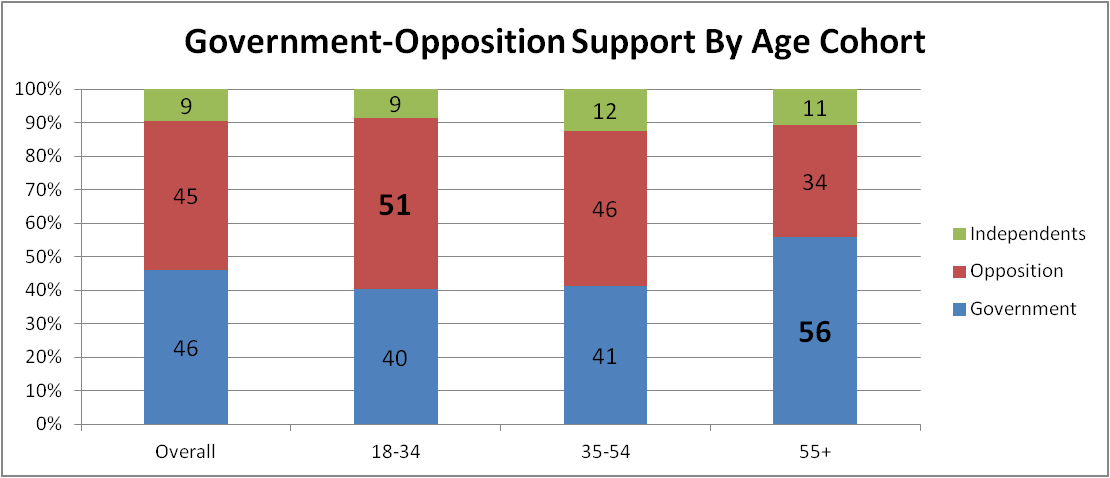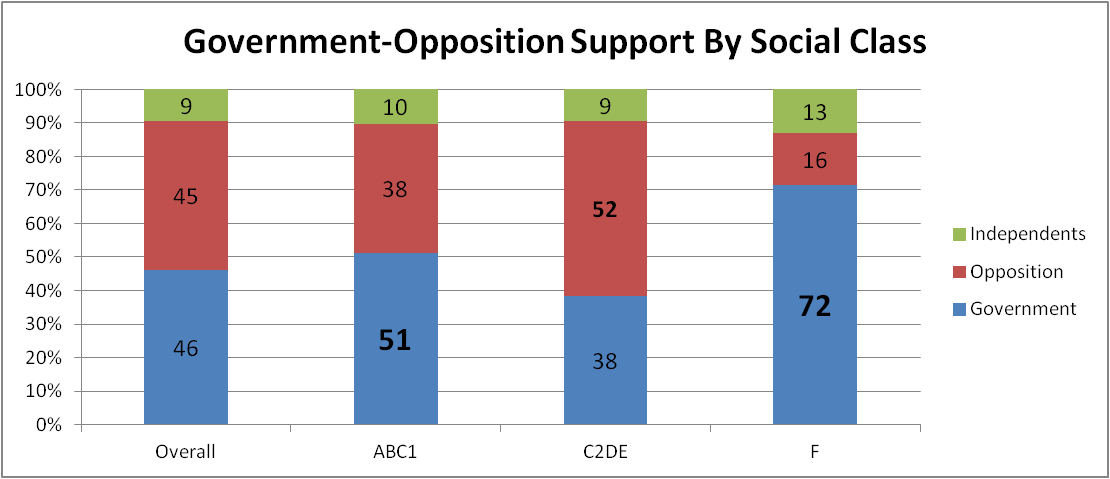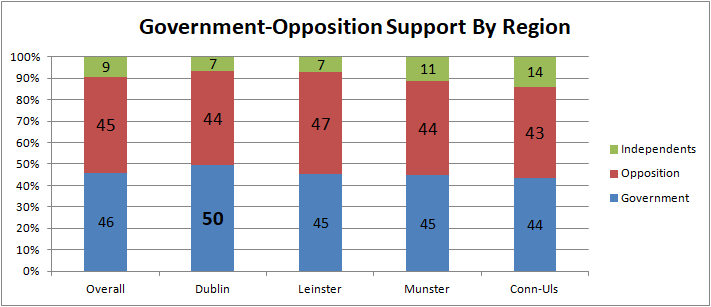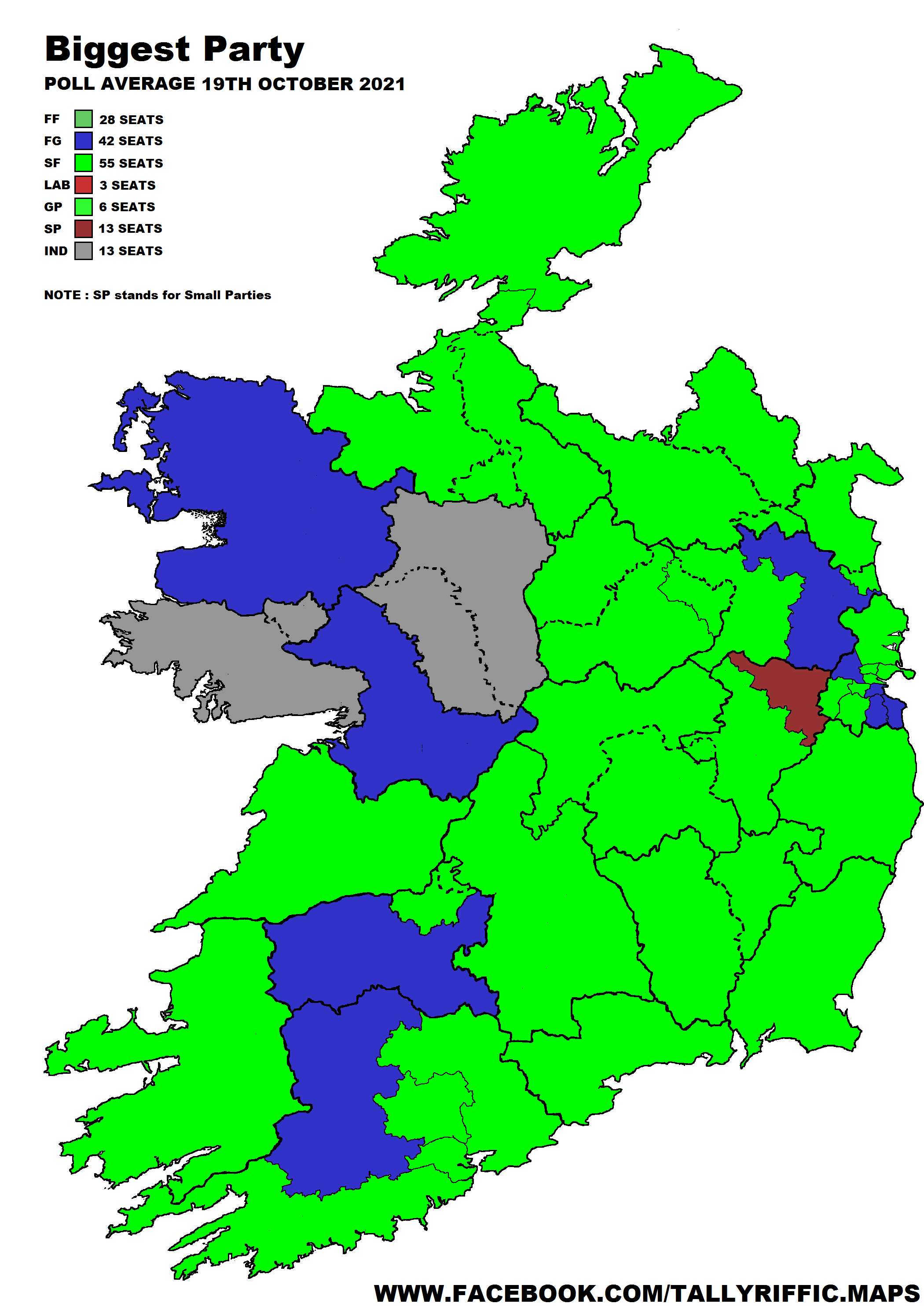I’ve done a time-weighted analysis of the last five Polls and using a Count Simulator have projected the outcomes as follows….

METHODOLOGY : The Country total and regional figures for each party/group are calculated using a time-weighted average from the last five poll. The Country Total is adjusted to ensure it is in line with the regional figures (some polls don’t issue regional data). The proportion each party loses (if anything) per region is then calculated. For instance if a party was at 18% and is now at 12%, it loses a third of its vote – if its vote was 24% in a constituency it falls to 16%, if it was 15% to 10% etc. Next it is determined what votes the gaining parties will receive – for instance Fianna Fáil votes might be (proportionately) more likely to go to Fine Gael than Sinn Féin etc. A simulation of a count in each constituency is processed – this uses transfer data from the 2020 General Election, and in 16 constituencies uses transfer data particular to that constituency (if we are looking at transfers based on 2020 transfer rates).
Also – in 2021 Sinn Féin received well over a quota worth of votes in many constituencies due to their only running one candidate (in Louth, Cavan-Monaghan and Donegal, they received well over two quotas with two candidates). In these constituencies, I’ve added a “dummy” 2nd SF candidate who takes one-third of the Sinn Fein vote.
It should be noted that these are merely the outcomes if regional swings were replicated in constituencies in that region. No attempt is made to factor in individual circumstances in each constutuency.
DUBLIN : The Count simulator forecasts that Fianna Fáil vote would fall marginally in Dublin leading to the loss of three of their seven seats – two to Fine Gael (Dublin North-West and Dun Laoghaire), and the third to an Independent in Dublin South-West (It should be noted that this is predicated on their being a strong independent in the field – one would presume it’s unlikely that Katharine Zappone will be rejoining the fray).
Fine Gael’s vote is forecast to rise by 6 points, leading to the two gains aforementioned as well as a gain from the Green Party in Dublin South-Central. Labour would lose their seat in Fingal to Sinn Féin, but retain Dublin Bay North. The Greens would vote would fall slightly in the Capital and would lose their Dublin West seat (probably to a left-wing candidate) as well as the aforementioned loss in Dublin South-Central – so at present they are not facing the complete whitewash they experienced in Dublin in 2009 and 2011. Sinn Féin – in stark contrast to the rest of the country – would see their vote fall marginally, although they would still gain a seat in Dublin South-Central (probably at the expense of a left-wing candidate).
Close races might include : Dublin Bay North (between Fianna Fáil and Sinn Féin), Dublin Bay South (between Fianna Fáil and Fine Gael), Dublin South-Central (between Fine Gael and the Greens), Dublin South-West (between the Greens and Fianna Fáil), Dublin West (between Solidarity/People Before Profit and the Greens), Dun Laoghaire (between Fine Gael and Fianna Fáil) and Dublin Central (between the Social Democrats and Sinn Féin)
LEINSTER : The Count simulator forecasts that Sinn Féin would win five extra seats in Leinster – in Carlow-Kilkenny (from the Greens), Laois-Offaly (from Fianna Fáil or Independents), Louth (from Labour), Wexford (from Independents) and Wicklow (from Fianna Fáil or the Greens). Taking three seats in Louth could prove difficult given the particular geography at play with the majority of the population living in and around two very large towns at opposite ends of the constituency both of which already host Sinn Féin TDs. Also in practice Labour could prove hard to unseat given their strong base in Drogheda.
On the other hand, geography could play to their hand in Wicklow where most unusually all five TDs are based in the urban north-east catchment area of Bray and Greystones – a Sinn Féin candidate in South or West Wicklow could likely capitalise). Fine Gael are forecast to win just one extra seat in Wicklow. Fianna Fáil are forecast to lose three seats – in Longford-Westmeath, Laois-Offaly and Wicklow – although the fact that the loss of a Laois Fianna Fáil seat would likely go to an Offaly candidate does mean that it might be easier for Fianna Fáil to hold on. Also – the fact that Athlone currently does not have a TD is likely to inform preferences in the western half of Westmeath at the next General Election. The Greens appear very vulnerable in both Wicklow and particularly Carlow-Kilkenny where they only took a seat due to Sinn Féin not running a second candidate in 2020.
Close races might include : Kildare South (between Independents and Labour) and Wicklow (between Fine Gael and Fianna Fáil)
MUNSTER : Opinion Polls have been suggesting a substantial rise in Sinn Féin support in Munster and accordingly the Count Simulator awards them nine gains – Cork East (from Labour), Cork South-Central, Cork South-West and Cork North-West (from Fianna Fáil), Limerick County and Kerry (from Independents), Cork South-West (from Fianna Fáil or the Social Democrats), Limerick City (from the Greens) and finally Waterford (from the Greens or Independents) – Fine Gael would also gain seats in Cork South-West and Waterford.
In Cork East, there is a strong base for Labour in Mallow, but they are vulnerable to a strong 2nd Sinn Féin candidate. Cork North-West was the only constituency in the state without a Sinn Féin candidate in 2020 (and the only one where Fianna Fáil and Fine Gael combined won every seat), but the fact that Aontu, the Social Democrats and the Greens combined polled over 10,000 votes between suggests that the desire for change didn’t completely bypass Cork North-West and that it will be hard for the main Government parties to maintain a complete hegemony on the constituency next time around. In Waterford, they would take nearly half the vote and so might be tempted to try and take 3 seats although precise vote management would be required. Fine Gael could also expect gain in Tipperary (from Labour).
Close races might include : Cork North-Central (between Fianna Fáil, Sinn Féin and Solidarity-People Before Profit); Cork South-Central (between Sinn Féin and Fianna Fáil); Cork South-West (between Independents and the Social Democrats) and Limerick City (between Sinn Féin and Independents)
CONNAUGHT-ULSTER : An eight point rise in Sinn Féin’s rating would see them win three extra seats – Donegal (from Independents), Galway East (from Fianna Fáil) and Sligo-Leitrim (from Fine Gael). Fine Gael would however make a gain in Roscommon-Galway from Independents. Finally the Social Democrats might take a seat from Independents in Galway West.
Close races might include : Galway West (between the Social Democrats and Independents)
| SF | IND | ||||||||
| SF | FF | ||||||||
| OTH | IND | ||||||||
| FG | IND | ||||||||
| SF | FG |
CLASS : Fine Gael has consistently led amongst Middle-Class voters since the election rising to over 40% around Christmas – they since have fallen over 10 points and are now just over five points ahead of Sinn Féin.

By contrast, Sinn Féin have maintained a consistent lead amongst working-class voters since the election and now lead Fine Gael by over 2-to-1 amongst this voter cohort. Fianna Fáil have generally been polling in the mid-teens but are now drawing level with Fine Gael.

The Farming Vote graph is a bit messy due to low sample size and infrequent polling – at the moment the average is Fine Gael 42% Fianna Fáil 28% Sinn Féin 10% Labour 1% Green Party 0% Others 5% Independents 14%.
Overall, both Fine Gael and Sinn Féin show marked class-based support biases – the same true is true of The Greens at a lower level of support. Fianna Fáil has a more balanced support base.
AGE : Sinn Féin have consistently lead amongst voters aged 18-34 since the General Election, although Fine Gael were a close second in late 2020. Now however Sinn Féin are polling over 40% amongst this cohort and are leading Fine Gael by 2-to-1. The Greens also remain relatively strong amongst this cohort.

Amongst Middle-aged voters Sinn Féin and Fine Gael have been in close contest, although Sinn Féin have pulled ahead over the last few months. Fianna Fáil support amongst this age cohort is very much similar to its support amongst younger voters.

Fianna Fáil fare better amongst older voters – those 55 and over – than amongst those in lower age cohorts and are currently tied for second place with Sinn Féin. Fine Gael had a commanding lead at the end of last year but are now just 5% ahead of Fianna Fáil and Sinn Féin.

GOVERNMENT Vs OPPOSITION SUPPORT BY REGION, CLASS AND AGE :
The Opposition (Sinn Féin, the Social Democrats, Labour and Solidarity-People Before Profit) enjoy leads amongst people under 55 – but the Government has an almost two-to-pne lead amongst those over 55.

The Government leads by 13 points amongst Middle-Class voters; the Opposition leads by 14 points amongst Working-Class voters. The Government also has the support of nearly three-quarters of Farmers. The advantage the Government has amongst Middle-Class voters is driven by the middle-class biases of Fine Gael and Green Party support, and similarly Sinn Féin’s disproportionately working-class support is largely the reason for the opposition’s advantage amongst Working-Class voters.

The Government has the support of half of the voters in the capital – the regions are more evenly pitched with the opposition narrowly leading in Munster and Connaught-Ulster.

BIGGEST PARTIES :

MAIN POINTS
Sinn Féin’s extra support seems to be coming from outside Dublin and is particularly accentuated in Munster. It’s long known that there are marked age and class factors to Sinn Féin’s vote, but is there an emerging regional factor as well? Despite actually losing ground in Dublin, they would still gain a seat there – but wouldn’t gain extra seats they might hope to pick up on last year’s election results.
Fianna Fáil is the most cross-class of the main parties, but voters over 55 form a disproportionate part of their support base. Nevertheless, this time last year they might have struggled to reach 20 seats so they have made slow progress since that time.
Fine Gael continues to perform strongly in the capital and still out-performs Sinn Féin, but elsewhere they are nearly back to their General Election level and would only pick up a handful of seats outside the capital.
Several Independents would lose seats according to these figures, but Independents are often underestimated in polls outside election campaigns.